The most important tool in any shop
It’s my contention that there is only 2 tools you MUST HAVE in any woodworking shop.
1. A saw of some kind (Sure you could probity cut wood with a chisel but it sure would take a long time, and while I’m pretty good with a hatchet a saw is a lot more versatile). If I only had one saw to choose from I would grab a 240mm Ryoba (Is it cheating that it’s 2 saws in one? :-D).
2. A workbench
Thousands of articles and books have been written on the subject and I’m certainly not an expert. If you want the current definitive book on the subject, go grab “Workbenches: From Design And Theory To Construction And Use” by the master himself, “The Schwarz”.
Long story summed up:
1. You need something relatively flat.
2. You need to be able to secure your work to the bench
3. You don’t want to bench to move or flex while you are working
Since I started on this woodworking journey almost 2 years ago I’ve made do with a 2×4 construction lumber table that was screwed to the wall.
As I started down my journey of hand tool usage I quickly found defecates and came up with solutions to those defecates.
Using the principles found in Fine Woodworking’s Getting Started in Woodworking video series I was able to add an MDF laminated top and a quick release vice. That bench served me very well and I was able to get started for less than $100.
Due to a recent move I was forced to leave my starter bench behind attached to old house. Luckily for me the original owner and builder of our new house was a woodworker and left this great bench! (that’s a Stanley #608 jointer on there for size reference)
While the bench was incredibly out of level and uneven, there is a whole lot of wood here and there and the base is solid!
 After a bit of planing I was able to determine that the top was made out of 4/4 Walnut about 3.5″ thick.
After a bit of planing I was able to determine that the top was made out of 4/4 Walnut about 3.5″ thick.
It was fairly beat up and there are a number of nails that later caused me a fair bit of cussing. One interesting element is this cool little pop up planing stop.
Further investigation revealed that the top was nailed together as opposed to glued. While I’m sure it would have been just fine to leave it like that, I decided I wanted it a bit more solid so thus begin the following process.
Retrofitting an old bench:
 I did a bit of rough flattening on the top and then took the top off and flipped it over.
I did a bit of rough flattening on the top and then took the top off and flipped it over.
I got myself some West System Epoxy and mixed a slow set epoxy with some 404 High Density Filler and a bit of brown dye to make the white filler not stand out so much.
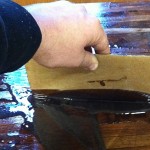 After that it was just a matter of spreading the epoxy over the surfaces and allowing it to seep down into all the cracks.
After that it was just a matter of spreading the epoxy over the surfaces and allowing it to seep down into all the cracks.
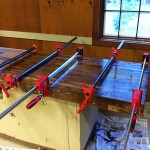 Make sure you have a good selection of long clamps if you ever attempt anything like this. I had to get a few more!
Make sure you have a good selection of long clamps if you ever attempt anything like this. I had to get a few more!
Vice Selection:
I launched myself into this process with no idea what I was going to do when it came to work holding. The original bench had a leg vice. While these have been all the rage due to the resurgence of the Roubo bench that Christopher Schwarz’s book popularized, I’m not a huge fan.
As for a tail vise, there wasn’t one at all on this original bench. I hemmed and hawed long and hard and put off my decision and managed to procrastinate so long that I still hadn’t decided when it came time to head to Wood Working In America in October (this workbench project began July). This turned out to be a hidden blessing.
enter some really inventive Canadians…..
While at WIA I stumbled across a new product by Lee Valley – Veritas® Quick-Release Sliding Tail Vise. If there ever was a tail vise intended for bench retrofitting, it’s this one!
One thing to consider with this vice. You have to put a skirt that is at least 3 5/8″ blow the bottom of the rest of your bench top (in my case that meant I needed almsot a 7.5″ wide skirt). This will limit some clamping options (and add a few others).
installation…..
 I decided that if I was going to be putting a shirt on the front I may as well just border the entire bench. (It needed end caps anyway). I got a hold of some 12/4 Ash and decided it would be perfect for this application.
I decided that if I was going to be putting a shirt on the front I may as well just border the entire bench. (It needed end caps anyway). I got a hold of some 12/4 Ash and decided it would be perfect for this application.
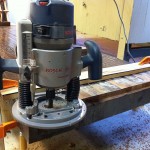 I used a router to make rabbets in the ends of the bench and bolted on the end caps (making sure to drill slotted holes for the bolts to allow for wood movement).
I used a router to make rabbets in the ends of the bench and bolted on the end caps (making sure to drill slotted holes for the bolts to allow for wood movement).
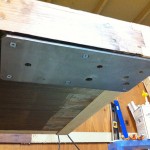 Once that process was completer the vice installation was as breeze! First you carefully measure and place a metal plate on the bottom of the table.
Once that process was completer the vice installation was as breeze! First you carefully measure and place a metal plate on the bottom of the table.
 Then it’s just a matter of drilling holes for all the lag bolts and anchors and bolting the vice in place.
Then it’s just a matter of drilling holes for all the lag bolts and anchors and bolting the vice in place.
Really the only hard part is holing and positioning the vice while putting in the lag bolts (an extra set of hands to hold the vice or to help flip the bench over would have been handy :)… but as the weight this bench is, flipping it myself is about the bottom of the things I want to tackle.)
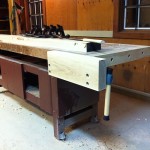 And presto vice installed! As you can see I did the vice install before I did the rest of the skirt. No particular reason, other than I wanted to play with the new toy…. of course a one sided vice doesn’t’ do much good 😀
And presto vice installed! As you can see I did the vice install before I did the rest of the skirt. No particular reason, other than I wanted to play with the new toy…. of course a one sided vice doesn’t’ do much good 😀
It ended up being a few more weeks before I got back to this project but I got all the dog holes drilled in the skirt and attached it. I also replaced the metal pop-up planing stop with a big ash one that goes all the way through the bench.
So how do I like the vise? Works great!!!!! the quick release is nice and smooth and you can apply more than enough pressure and clamping force with it. I still need to drill some holes along the face of the skirt and the front of the vice to allow clamping along that face.
Is it perfect? No I really wish it would reengage the threads as soon as you started turning the handle. Instead you have to flip the quick release lever back down. Not a big deal… but it would have been nice if it was automatic.
Really that’s the only flaw I’ve found so far.
It’s easy to install and it works great.
As for a face vice?
Well that’s still being decided. I’m thinking I’ll go with a twin screw vice to allow joinery and dovetail work on the ends of wide boards…. but I hear rumor those crazy inventive Canadians are working on some sort of new quick release face vice so who knows….. these days there always seems to be some new improved product just around the corner. It’s a good time to be a woodworker.
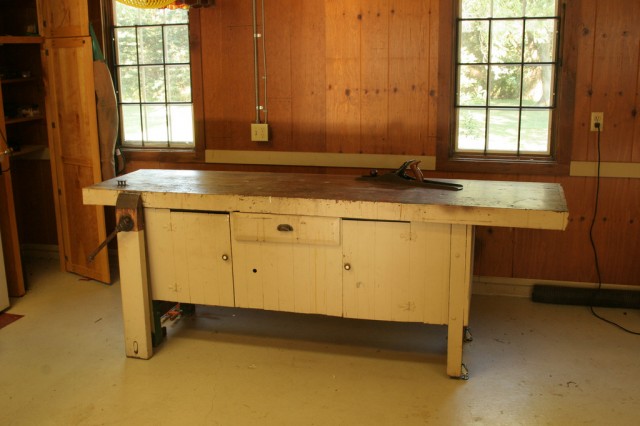
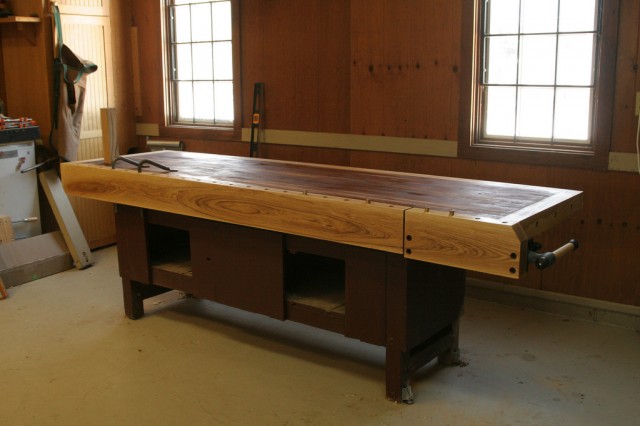
Nik,
Well done, my friend. Looks like you got a nice bench with your house and turned it into a great bench.
I’m curious, how is the epoxy coated top holding up to use?
Oops guess I didn’t make that clear. after all the epoxy dried I planed the bench flat just like a normal bench. The epoxy was just to seep in between all the loose boards and dry while in clamps (and fill a few holes). I did a full flattening down to 1/32″ after all the epoxy dried. It just has a standard soaking of Watco Danish oil on it now.